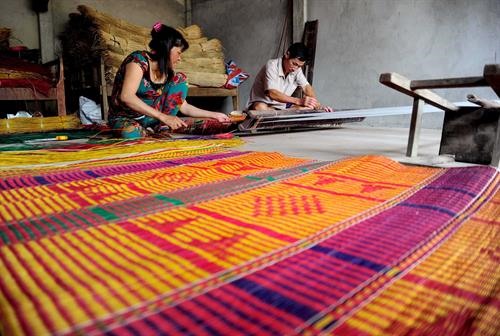 Society
Society

Three ethnic Khmer handicraft villages in Trà Vinh Province’s Trà Cú District have expanded over the last four years due to high demand and support from local authorities.
 |
| Hàm Tân sedge mat weaving village in Trà Vinh Province’s Trà Cú District has produced items for nearly 100 years. – VNA/VNS Photo An Hiếu |
TRÀ VINH – Three ethnic Khmer handicraft villages in Trà Vinh Province’s Trà Cú District have expanded over the last four years due to high demand and support from local authorities.
Two of the handicraft villages are in Đại An and Hàm Giang communes, as well as the sedge mat weaving village in Hàm Tân Commune.
The Đại An handicraft village uses bamboo to make tables, chairs, baskets, fish catching tools and other houseware items as well as souvenirs and decorative items for houses, entertainment places and resorts.
The Hàm Giang handicraft village also uses bamboo to produce high-class beds, tables, chairs and other houseware items, all in high demand by restaurants and tourism sites.
To improve transport to the three villages, the province spent more than VNĐ9.6 billion (US$410,000) to build nine concrete roads with a total length of 8.2km, according to the province’s Department of Industry and Trade.
Thạch Chi Na, who makes houseware items in Hàm Giang handcraft village, said with the province’s support, many households making handicraft products in the village have worked since 2015 to set up a handicraft co-operative team.
The village products sell locally and in provinces including Bến Tre, Sóc Trăng, Cà Mau and Bạc Liêu, he said.
Workers at the village have an average daily income of VNĐ200,000 – 250,000 ($8.6 – 10.7).
Last year, the Department of Industry and Trade gave VNĐ404 million ($17,300) to a household producer Trì Cảnh in Hàm Giang handicraft village to build a workshop, buy facilities and provide vocational training for its 20 workers.
In the first quarter of the year, the department offered consultancy to Trì Cảnh to set up its showroom, design its logo and make new products.
In Đại An handicraft village, more than 60 locals are making handicraft products.
According to Đồ Văn Dưng, deputy chairman of the Đại An Commune People’s Committee, production cannot meet the high demand. Products such as baskets, flower vases and flower baskets are favoured by tourists, restaurants and hotels.
The village earned total revenue of VNĐ6 billion ($257,000) from selling handicraft products last year.
However, the two villages are facing a shortage of materials as locally grown bamboo only meets 30 per cent of their needs.
Most bamboo materials have to be bought from other provinces, causing high production costs.
In Hàm Tân sedge mat weaving village, locals have produced various types of sedge mats for nearly 100 years.
The village is famous for its high-quality white-coloured sedge mats and colored, patterned sedge mats.
Hàm Tân has more than 2,250 households. Of these, 478 of them weave mats and 91 grow sedge for making mats.
The village produces more than 140,000 sedge mats a year.
Normally, two people working together can weave two sedge mats measuring 2 metres long by 1.6 metres a day and earn a profit of VNĐ60,000 -70,000 ($2.5 - 3).
Liêng Phước Thiện, chairman of the Hàm Tân Commune People’s Committee, said: “In Hàm Tân, most people know weaving sedge mats. Besides working on fields, people use their free time to weave sedge mats.”
The commune has also provided money for locals to buy sedge for weaving mats or to plant sedge to increase income.
The province’s researchers have also created mat weaving machines to weave mats more quickly compared to manual weaving.
It also has helped villagers buy mat weaving machines to improve productivity.
Trần Minh Cảnh in Hàm Tân was provided with 50 per cent of the cost of buying a mat weaving machine, worth VNĐ35 million ($1,500) in 2016.
The mat weaving machine helped his family weave 10 to 12 sedge mats a day.
Previously, his family could only make four sedge mats a day via manual weaving.
The commune now has five mat weaving machines. – VNS